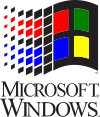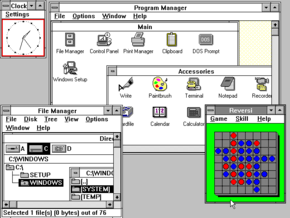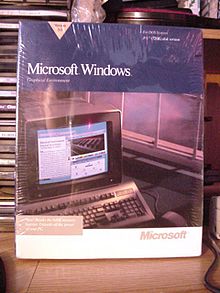- Windows 3.0
-
Windows 3.0 Part of the Microsoft Windows family 

Screenshot of Windows 3.0 Developer Microsoft Releases Release date 22 May 1990[info] Current version 3.00a
Multimedia Extensions (October 20, 1991)[info]Source model Closed source License MS-EULA Preceded by Windows 2.1x Succeeded by Windows 3.1x Support status Unsupported as of 31 December 2001 Windows 3.0, a graphical environment, is the third major release of Microsoft Windows, and was released on 22 May 1990. It became the first widely successful version of Windows and a rival to Apple Macintosh and the Commodore Amiga on the GUI front. It was followed by Windows 3.1.
Contents
Features
Windows 3.0 succeeded Windows 2.1x and included a significantly revamped user interface as well as technical improvements to make better use of the memory management capabilities of Intel's 80286 and 80386 processors. Text-mode programs written for MS-DOS could be run within a window (a feature previously available in a more limited form with Windows/386 2.1), making the system usable as a crude multitasking base for legacy programs. However, this was of limited use for the home market, where most games and entertainment programs continued to require raw DOS access.
The MS-DOS Executive file manager/program launcher was replaced with the icon-based Program Manager and the list-based File Manager, thereby simplifying the launching of applications. The MS-DOS Executive is also included as an alternative to these. The Control Panel, previously available as a standard-looking applet, was re-modeled after the one in Mac OS. It centralized system settings, including limited control over the color scheme of the interface.
A number of simple applications were included, such as the text editor Notepad and the word processor Write (both inherited from earlier versions of Windows), a macro recorder (new; later dropped), the paint program Paintbrush (inherited but substantially improved), and a calculator (also inherited). Also, the earlier Reversi game was complemented with the card game Solitaire.
The Windows icons and graphics were redesigned to take advantage of VGA's 16-color mode. Earlier versions only supported eight colors though could run on monochrome video adapters. Windows 3.0 also allowed the user to use a 256 color video adapter, whereas previous versions only supported 16 colors.
Windows 3.0 includes a Protected/Enhanced mode which allows Windows applications to use more memory in a more painless manner than their DOS counterparts could. It can run in any of Real, Standard, or 386 Enhanced modes, and is compatible with any Intel processor from the 8086/8088 up to 80286 and 80386. Windows 3.0 tries to auto detect which mode to run in, although it can be forced to run in a specific mode using the switches: /r (real mode), /s ("standard" 286 protected mode) and /3 (386 enhanced protected mode) respectively. Due to this backward compatibility of the whole system, Windows 3.0 applications also must be compiled for 16-bit mode, without ever using the full 32-bit capabilities of the 386 CPU.
This was the first version to run Windows programs in protected mode, although the 386 enhanced mode kernel was an enhanced version of the protected mode kernel for Windows/286.
A "multimedia" version, Windows 3.0 with Multimedia Extensions 1.0, was released later in 1991. This was bundled with "multimedia upgrade kits", comprising a CD-ROM drive and a sound card, such as the Creative Labs Sound Blaster Pro. This version was the precursor to the multimedia features available in Windows 3.1 and later, and was part of Microsoft's specification for the Multimedia PC.
Windows 3.0 was the last version of Windows to advertise 100% compatibility with older Windows applications.[1] This only applies to real mode.
System requirements
The official system requirements for Windows 3.0:
- 8086/8088 processor or better
- 384K of free conventional memory (real mode, protected modes require more)[2]
- Hard disk with 6-7MB of free space
- CGA/EGA/VGA/Hercules/8514/A graphics and an appropriate and compatible monitor
- MS-DOS version 3.1 or higher[3]
Also, a Microsoft-compatible mouse is recommended.
Memory modes
Windows 3.0 was the only version of Windows that could be run in three different memory modes:
- Real mode, intended for older computers with a CPU below Intel 80286, and corresponding to its real mode;
- Standard mode, intended for computers with an 80286 processor, and corresponding to its protected mode;
- 386 Enhanced mode, intended for newer computers with an Intel 80386 processor or above, and corresponding to its protected mode and virtual 8086 mode.
Real mode primarily existed as a way to run Windows 2.x applications. It was removed in Windows 3.1x. Almost all applications designed for Windows 3.0 had to be run in Standard or 386 Enhanced modes. However, it was necessary to load Windows 3.0 in Real mode to run SWAPFILE.EXE, which allowed users to change virtual memory settings.
Standard mode was used most often as its requirements were more in-line with an average PC of that era – a 286 processor with at least 1 MB of memory. Incidentally, not all 286 and 386 computers remapped memory between 640 KB (the upper limit of Conventional memory) and 1 MB as extended memory — some did not show memory between 640 KB and 1 MB at all — so on some systems with 1 MB of RAM, there is no extended memory and memory was limited to 640 KB. On such a system, Windows was limited to real mode. Many 386 computers ran Windows 3.0 in Standard mode due to a lack of memory.
386 Enhanced mode implemented all the benefits of Standard mode, plus 32-bit addressing and paging for faster memory access, and virtual 8086 mode for safer execution of MS-DOS programs: each of them now ran in a virtual machine. In the previous modes, multiple MS-DOS programs could only be run in full-screen, and only the program currently active was executing; but in 386 enhanced mode, they could be run simultaneously in separate windows. This mode required a 386 processor and 1 MB of extended memory (in addition to the base 640KB) – beyond the specifications of most PCs sold in 1990.
Multimedia Extensions
The Multimedia Extensions were released in autumn 1991 to support sound cards, as well as CD-ROM drives, which were then becoming increasingly available. The Multimedia Extensions were released to Original Equipment Manufacturers (OEMs), mainly CD-ROM drive and sound card manufacturers, and added basic multimedia support for audio input and output and a CD audio player application to Windows 3.0. The Multimedia Extensions' new features were not available in Windows 3.0 real mode. Windows 3.1x would later incorporate many of its features. Microsoft developed the Windows Sound System sound card specification to complement these extensions.
The MME API was the first universal and standardized Windows audio API. Wave sound events played in Windows (up to Windows XP) and MIDI I/O use MME. The devices listed in the Multimedia/Sounds and Audio control panel applet represent the MME API of the sound card driver.
MME lacks channel mixing, so only one audio stream can be rendered at a time. MME supports sharing the audio device for playback between multiple applications starting with Windows 2000, up to two channels of recording, 16-bit audio bit depth and sampling rates of up to 44.1 kHz with all the audio being mixed and sampled to 44.1 kHz.
Marketing
This version of Windows was the first to be pre-installed on hard drives by PC-compatible manufacturers. Zenith Data Systems had previously shipped all of its computers with Windows 1.0 or later 2.x on diskettes but committed early in the development of Windows 3.0 to shipping it pre-installed. Indeed, the Zenith division had pushed Microsoft hard to develop the graphical user interface because of Zenith's direct competition with Apple in the college and university market.
Windows 3.0 was not available as a run-time version, as was the case with its predecessors. A limited-use version of Windows 2.x was often bundled with other applications (i.e. Ami Pro) due to the low market penetration of Windows itself. It again was unsupported after December 31, 2001.
References
- ^ Mark Ward (5 November 2008). "The end of an era - Windows 3.x". BBC News. http://news.bbc.co.uk/2/hi/technology/7707016.stm. Retrieved 4 September 2009.
- ^ Windows 3.0 Modes and Memory Requirements http://support.microsoft.com/kb/58317
- ^ Windows Version History http://support.microsoft.com/kb/32905
External links
- GUIdebook: Windows 3.0 Gallery - A website dedicated to preserving and showcasing Graphical User Interfaces
- Windows 3.1 Rocks Mailing List Support, links and freeware downloads for users of Windows 3x.
- Windows 3.0 Modes and Memory Requirements
Microsoft Windows family DOS-Based Windows 9x Windows NT Client releasesWindows XP (editions [x64 · Media Center] · development) · Windows Vista (editions · development) · Windows 7 (editions · development) · Windows 8Server 2003 · Server 2008 (Server 2008 R2 · HPC Server 2008 · EBS 2008) · Home Server (Home Server 2011) · MultiPoint Server · Small Business ServerSpecializedWindows Embedded (Automotive · POSReady) · Windows Preinstallation Environment · Windows To Go · Windows Fundamentals for Legacy PCsWindows CE Mobile Windows Mobile · Windows PhoneCancelled Related topics Notes:
- ^ These operating systems have both client and server editions.
Categories:- 1990 software
- Discontinued versions of Microsoft Windows
Wikimedia Foundation. 2010.

